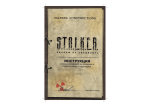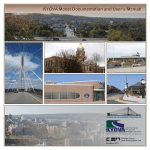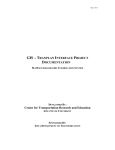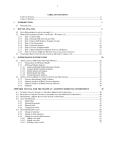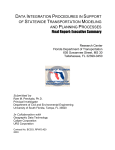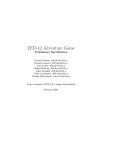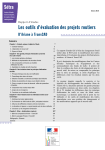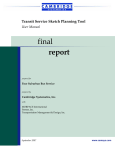Download Training on TransCAD Software
Transcript
The Ministry of Education of the Republic of Azerbaijan Training on TransCAD Software Credit No: 4595 AZ Training Completion Report WA R N E R TRANSPORTATION CONSULTING, INC. 177 Riverside Drive Northampton, MA 01062 413 585-5026 June 20, 2012 Training on TransCAD Software—Training Completion Report Contents EXECUTIVE SUMMARY ................................................................................................... 2 TRAINING DELIVERY METHODOLOGIES ............................................................................... 3 TRAINING CONTENT ..................................................................................................... 4 Monday, April 23 .................................................................................................. 4 Tuesday, April 24 ................................................................................................. 5 Wednesday, April 25 ............................................................................................. 6 Thursday, April 26 ................................................................................................ 8 Friday, April 27 .................................................................................................. 10 EVALUATION FINDING AND FEEDBACK BY TRAINER(S) ............................................................ 11 CHALLENGES AND DIFFICULTIES ENCOUNTERED DURING THE TRAINING ........................................ 11 LESSONS LEARNED AND RECOMMENDATIONS ...................................................................... 12 FOLLOW-UP AND SUSTAINABILITY ................................................................................... 13 CERTIFICATION ........................................................................................................ 16 ANNEXES .............................................................................................................. 16 THE TRAINING TEAM MEMBERS INCLUDING NAMES, SURNAMES AND TITLES................................... 18 THE TRAINEES.......................................................................................................... 19 PRE-COURSE SURVEY OF PARTICIPANTS ............................................................................ 20 SAMPLE CERTIFICATE ISSUED TO STUDENTS ....................................................................... 22 Annexes sent separately: • • • • Lesson Plans and Hand-out Notes The compilation of training materials/handouts User's guide for the Baku TransCAD model. Options for TransCAD purchases memo. WARNER TRANSPORTATION CONSULTING Page i Training on TransCAD Software—Training Completion Report Executive Summary Training Title Training on TransCAD Software Training Goal and Objectives The training program aimed to provide the selected transportation specialists with practical knowledge and appropriate professional skills in TransCAD software in order to use it effectively and productively, with a focus on transportation planning and forecasting. Training Dates April 23 to 27, 2012 Training Target Group The target group was specialists from the Azerbaijan Ministry of Transportation, including: Traffic engineers, Traffic organization specialists, Engineers of Intellectual Management Transport Systems, Faculty members of the higher education institutions on relevant subjects or qualifications. The actual class had 17 students. Short Training Summary The course relied on demonstrations and guided hands-on exercises to give students experience with the type of TransCAD procedures they would most likely use. Students developed these skills by working with geographic maps and data and a TransCAD model developed for the Baku region. WARNER TRANSPORTATION CONSULTING Page 2 Training on TransCAD Software—Training Completion Report Training Delivery Methodologies The training methodology included the following: • Guided practice of structured examples using the Baku TransCAD model as a base. • Supporting discussions emphasizing the why in addition to the how. For each model step, we discussed what the step does, how it fits in a systematic modeling process, and why it is important to use the right data and formulas. We discussed good modeling practices, based on examples from the Baku model and others. • Independent practice of steps relevant to particular lessons. Participants would work (either individually or in small groups) at a computer with TransCAD availability. • Handouts in Azerbaijani. These were mostly step-by-step instructions with illustrations for using TransCAD, but also flowcharts of model processes, and tables and charts of model parameters or travel patterns from other urban areas. • Question and Answer sessions at the end of each day—and informally throughout the day—to allow trainees to make sure they have understood what they have learned. Note that the course used a TransCAD model developed for the Baku area throughout the course and within each of the hands-on exercises. Class participants could thus see the material within a familiar context. WARNER TRANSPORTATION CONSULTING Page 3 Training on TransCAD Software—Training Completion Report Training Content This section summarizes proceedings of each training day. Monday, April 23 1. Introduction The course began with an introduction about the training objectives and a some examples of how TransCAD could be of use to the Ministry of Transportation and the Public Investment Capacity Building Program. The first session included an overview of the standard 4-step transportation model process, and a brief discussion of the history of transportation planning tools leading up to the realistic transportation models allowed by TransCAD. 2. Creating and Manipulating Maps Throughout the course, we worked with TransCAD maps and data for the Baku region. This first session focused on basic mapping skills--essential for preparing model inputs, and for presenting model results. Students opened and moved around the Baku map. We discussed the concept and types of geographic layers. We zoomed in and out at different parts of the map, set the scale, added a legend, added a symbol, “bookmarked” a particular geographic area (for example, Central Baku or the Absheron Peninsula), and copied a TransCAD map into a Word document. In the guided example conducted with the trainer, students zoomed in, put a symbol, added a label, and recorded the latitude and longitude for the ITMC (where the training occurred). Students subsequently did these tasks alone or in groups of two or three for a particular station of the Baku Metro. 3. Mapping Your Own Data and Spatial Analysis The trainer presented examples of thematic maps created with TransCAD, and we discussed the type of theme that would be most appropriate to show different types of data (such as traffic volumes, change in population, or passenger boardings at bus stops by time-of-day). Through guided demonstrations and independent exercises, students created their own thematic maps. In one example, they linked population data to the Transportation Analysis Zone (TAZ) layer, and created a new formula for population density. (An unexpected outcome here was to discover that some of the computers had TransCAD loaded with the default distance unit as miles, and some with the default distance unit as kilometers. After some confusion about the cause of different answers, we revised all the settings to show distances in kilometers.) Note that the data used in the course for the Baku regional model came from files prepared by ROM consultants in 2005 and then used in a subsequent consulting effort by WSP-Finland. One point of the exercises was to highlight where improved WARNER TRANSPORTATION CONSULTING Page 4 Training on TransCAD Software—Training Completion Report data accuracy could lead to a more precise forecast of travel flows. The population density exercise, for example, showed far greater population density in much of Sumquayit than in any point in Baku. Students considered whether this looked right. We also created and examined a thematic map showing population and employment using a bar chart at the center of each TAZ. Was this a good map? No, there is too much overlap of the bar charts and is thus not clear. We then aggregated the data from the 1539 TAZs into the much smaller set of rayons. The students agreed that showing the data with a thematic bar chart at the rayon level was much more reasonable. Tuesday, April 24 3. Mapping Your Own Data and Spatial Analysis--continued We finished up a few points planned for Session 3 that we did not get to on Monday. This included using TransCAD to compile statistics on a data set, and the various TransCAD techniques for selecting features from a geographic layer. Students used the Baku map and TransCAD's "Select by Circle" tool to select TAZs within a fixed distance of a certain point. They also used the ”Select by Condition" tool to find TAZs where the population forecast for 2025 was more than 50 percent higher than the population listed for 2010. Also as part of this lesson, the trainer briefly discussed the TransCAD features of overlays and buffers, and showed examples of their use and of their usefulness. We did not spend further time (as initially planned) on developing these as a hands-on student exercise. 4. Creating and Modifying TAZs and Other Area Layers We examined the TAZ boundaries used by ROM and WSP-Finland for the Baku region, and discussed whether the modeled area and TAZ boundaries were consistent with good modeling practice. The students did a guided exercise of breaking the 1.9 kilometer TAZ along the Baku waterfront into two zones so as to separate the seashore park from the Sea Port Hotel and the site of the planned Crescent Hotel. Students created the new zone boundaries and modified the TAZ data. We looked at the zonal attributes that TransCAD calculated for the new zones. Was this reasonable for all zones? Students noted that population density was a variable requiring recalculation. (The reported 6900 residents of the seashore TAZ-essentially the waterfront park--also highlighted data with room for improvement.) 5. Creating and Modifying Road Networks WARNER TRANSPORTATION CONSULTING Page 5 Training on TransCAD Software—Training Completion Report We opened and examined the TransCAD road layer prepared by ROM and used by WSP Finland in the Baku regional analysis. We discussed the line layer (the road segments), the node layer (the intersections), and the data in both. The trainer highlighted one-way roads, overpasses/tunnels, and dualized roadways such as Heydar Aliyev Avenue. We also discussed the lines coded on the road layer that are not real roads (TAZ centroid connectors) but that are necessary for transportation modeling. We discussed the sources for road information such as capacity determinants and free flow speeds, and why this information mattered to the regional model. We used TransCAD's feature display settings to show the road layer with different width and colors according to the road's functional classification (thereby distinguishing highways and other big roads from minor roads). In a hands-on exercise, the students added a bridge across the harbor with appropriate connecting roads. They revised the road layer database to include the bridge name and attributes about lanes, capacity, and free-flow speeds. In a second exercise, students converted two parallel roads south of Teymur Aliyev into one-way roads going in opposite directions. We also set up the road layer to allow TransCAD to find the shortest path between any two points selected by the user from all the nodes in the modeled region. We did tests with the shortest path determined by distance and by travel time and showed how these can differ. 5b--Determinants of Road Capacity and Speed Bakhtiyar Namazov, assistant professor at the Azerbaijan Technical University, spoke about the determinants of capacity and speed for roads in Azerbaijan. This included a description of free flow speeds based on certain design characteristics, and the performance functions that then estimate how travel speeds change in response to higher vehicle volumes and the number of trucks in the traffic flow. He presented information about various exceptions such as delays caused by weaves where highway entrances and exits are close together. Wednesday, April 25 6. Creating and Modifying Transit (Bus and Metro) Networks The class opened the Baku map and added the route system layer showing the area's bus and Metro routes. We discussed how TransCAD represents transit alignments: node to node route paths, designation of bus stops (or rail stations), and route data such as frequency, fare and speed (if on separate right-of-way from auto traffic. The transit routes were those coded in 2005 by ROM consultants. WARNER TRANSPORTATION CONSULTING It was Page 6 Training on TransCAD Software—Training Completion Report apparent to several students that many of the alignments and data for many of the routes were no longer (if ever) valid. We did a guided demonstration of using TransCAD's route editing tools to realign a portion of a bus route and to add new bus stops. We also used the editing tools to create a new hypothetical transit route across the modeled region. We created a transit network and used TransCAD tools to find the best transit path between various pairs of nodes throughout the region. 7. Trip Generation We discussed the role of the trip generation step in the transportation modeling process, the definition of "productions" and "attractions," and the benefits of accounting for distinct types of trip purposes (typically commute trips, home-based non-work trips, and non-home based trips). We discussed different trip generation formulas and their dependence on different types of population and land use data, and highlighted the benefits of knowing information about the types of activity within each TAZ (a McDonalds restaurant, for example, attracts many more trips than does a transportation planning firm with the same number of employees). The trainer showed examples of trip generation rates used in models of US urban areas, and contrasted this with findings from other regions around the world. The class did a hands on exercise applying TransCAD's Quick Response Method for trip generation using common US rates and applied to the limited TAZ-level data for Baku. Note that we did not have access to the model process files or parameters that ROM or WSP-Finland may have used in trip generation analysis. They do not seem to have compiled any data about retail shopping activity by TAZ. We used a simple formula to estimate retail employment as a function of total employment in the zone. Students opened the trip attraction rate file, modified the rates, and then re-ran the trip generation step. The class created and examined thematic maps of the results of trip generation. After some prodding, students recognized that the zone with Heydar Aliyev Airport had to attract far more trips than the model's trip generation step suggested. The trainer then used this as an example of the need to treat certain zones as "special generators" where the trip productions or attractions deviate significantly from the formulas applied to the region as a whole. We modified the trip Quick Response Method to treat the airport as a special generator. In the discussion of trip purposes, the trainer prompted the class to think about the components of non-home based trips and why these are important. After some prodding, the class identified that a large share of the trips that are not produced or attracted to someone's home are goods movement trips by truck. WARNER TRANSPORTATION CONSULTING Page 7 Training on TransCAD Software—Training Completion Report Finally in this session, we discussed the value of enhancing the TAZ data to include data on average household incomes, the percent of households owning an automobile, or the number of occupied hotel rooms in each zone. Each of these would add to precision in the model's ability to estimate the number of trips generated. We discussed how planning agencies and consultants elsewhere have collected or estimated this type of data. 8. Trip Distribution We discussed the place of trip distribution in the model process and the typical approach--the "gravity model"--used in transportation planning for linking trip productions and trip attractions. The trainer presented the mathematical formula, gave a simple example of how it works, and highlighted the assumptions used in the standard 4-step model application (round trip travel, use of auto times for impedance). We ran the trip distribution step as a group exercise for the Baku model, and looked at the trip length distribution chart for different trip purposes, a map showing commute (HBW) travel flows for trips into central Baku, and an orientation ratio for a particular downtown zone. We discussed if these made sense, and discussed enhancements that could improve model accuracy (parking costs and terminal times, further division of certain trip purposes by income group, consideration of transit times). Thursday, April 26 We lost a half hour this morning as the trainer tried to install an updated TransCAD model for the Baku region on the student computers. The model did not run, and he gave up the effort. He later discovered this to be a problem with a file naming convention that was not a problem on the trainer's computer. This problem affected the students' ability to run the full model, but they could still run model steps individually. 9. Mode Split The trainer described the place of mode split in the four-step transportation modeling process, and discussed with class input the types of trip and traveler characteristics that would influence someone's choice of modes (cars, public transport, or walk). The trainer presented a simple mathematical mode split example for one trip purpose between two TAZs to illustrate the basic concept of calculating a single WARNER TRANSPORTATION CONSULTING Page 8 Training on TransCAD Software—Training Completion Report "utility" value for each mode choice, and then using the logit formula to estimate the shares of this trip assigned to each mode as a function of the relative utilities. For which trips could you skip the mode split step in the regional model? After some prodding, the group understood that goods movement trips cannot use bus, metro, or walk. The model could assign these directly to trucks. The class examined TransCAD's "mdl" tool showing the structure and coefficients of the mode choice formulas as set up by the trainer for the Baku model. Note that we did not have access to any mode split formulas that ROM or WSP-Finland may have applied in the earlier Baku transportation studies. Thus, the formulas developed by the trainer were those that seemed reasonable, although they did not rely on survey data or actual bus and metro boardings needed for proper calibration. We ran the mode choice step and looked at the car, transport, and walk mode shares between different zones and inner Baku, and as calculated for the region as a whole. Students then doubled the bus and metro fares (from .2 to .4 manats), re-ran the mode split formula, and compared the results. The trainer expected that the walk share should have risen more than it did, but the general consensus among the students was that they would not have walked even ten minutes more to save .2 manats. 12. Production-Attraction to Origin-Destination and Time-of-Day Transformation The trainer very briefly explained the reasons why TransCAD has to convert the production-attraction format of trips to an origin-destination format. The second transformation--one that does require a user-defined input--is the split of the full day trips into smaller time periods. We looked at a graph of the hourly distribution of trips by trip purpose, and considered whether it was reasonable for Baku. We then opened the hourly table lookup file, and showed how to change the distribution. 10. Future Trends Affecting Transportation Planning Bakhtiyar Namazov presented information showing the very rapid growth of auto ownership in Baku over the past ten years, and showed how these rates have differed across the region. He discussed expectations of changes to this growth rate in coming decades. 11. Traffic Assignment WARNER TRANSPORTATION CONSULTING Page 9 Training on TransCAD Software—Training Completion Report We looked at the standard BPR function set up in TransCAD and showed examples of how estimated speeds drop with increasing volumes of passenger car equivalents or if changing the rates of parameters used in the formula. We discussed some advanced techniques to include intersection delays if the data permits it. Friday, April 27 12. Comprehensive Examples The trainer installed a fully working TransCAD model for the Baku region on each computer. Students used the TransCAD model interface to determine the input files and run the program for the 5PM to 6PM time period. Upon run completion (about 10 minutes for the single travel assignment hour), the students opened specified output files, and recorded key statistics about total vehicle hours and vehicle kilometers traveled, total trips by each mode, and the road link with the worst traffic congestion (measured by the volume to capacity ratio). Students then set up and tested various changes. Each of the changes required the students to use techniques learned in previous sessions of the course. The first test, for example, suggested that the population reported in the database for Baku was too low. Students then had to raise the 2010 population in all TAZs that are within ten kilometers of May 28 Metro Station by 25 percent, and raise the population of all other zones by 5 percent. Subsequent tests included adding road detail to the modeled region around Mashtaga, introducing a new bus service between Sumgayit and Turkan, raising bus fares by 25% and metro fares by 40%, setting the seaport as a special generator, and converting Heydar Aliyev Avenue to a bus-only facility. Students had time to figure out on their own how to make each of these changes. The trainer, the translator (Nadir Saracli), and other students helped out when called upon. 13. Final Material In the last hours of the class, the trainer showed the GISDK (TransCAD programming language) code for the Baku model. He talked again about the value of further data collection to make the Baku model more precise, and then described how the work we have done over the course for Baku could also apply to other urbanized areas throughout Azerbaijan. He showed how TransCAD provides built-in geographic layers with cities, major roads, and railroads that can help with this effort. WARNER TRANSPORTATION CONSULTING Page 10 Training on TransCAD Software—Training Completion Report Evaluation finding and feedback by Trainer(s) The pre-course survey suggested that the material covered in the class--both the use of TransCAD and the nature of travel forecasting models in general--was new to almost all of the students. Given this starting point, I assume that the students gained significant knowledge in these areas. It is also apparent by the efforts of the students on Friday that the students had generally gained a familiarity and competence with changing the land use and transportation system files needed for a TransCAD model run. These are the most common tasks that you would expect of someone using TransCAD in the Ministry of Transportation. There were only a couple of cases where I looked over a shoulder on Friday and was disheartened to see a student making a basic error (for example, trying to draw a new road on a map by using TransCAD's free-hand drawing tool when he should have been using the TransCAD geographic layer editing tool). The attitude of the students overall seemed excellent. Each student was punctual and many stayed after class to continue to work with the software. Challenges and difficulties encountered during the training The training went slower than I thought it would. I had to drop elements such as overlays and buffers to ensure that we had enough time on issues of greater importance. Students occasionally focused on some ancillary detail and may have missed the bigger point. For example, I created a thematic map with the intent of really highlighting that the data I got from WSP Finland could not possibly be right. We got so hung up on the simple task of matching the thematic map color scheme that the point about the specific data was lost. The course also had to overcome a challenge that arose before the training began. I had expected that I would be able to get the full set of files that previous consultants developed for the TransCAD model of the Baku region. This was not the case. I received the road layer, the TAZ layer, and the transport route system only two weeks before the course began, and nobody has been able to locate any model files used in the earlier consulting work. My sense now is that the earlier consultants (ROM and WSP-Finland) never actually had the data they felt they needed to develop a proper TransCAD model, and they thus developed an abbreviated four-step model without TransCAD's full functionality. For training purposes, however, I did need a model with all the parts operational: the model would have to yield a forecast, even if the forecast were not particularly likely. I might have used a completed and validated model from another urban area, but this would have undermined the value of working with the road, transport, and land use files in the context WARNER TRANSPORTATION CONSULTING Page 11 Training on TransCAD Software—Training Completion Report most familiar to the Azerbaijani students. Given this situation, I hastily built a Baku model. The model worked by the time the course began, but some of the interfaces and code had room for improvement. I am sure I would have caught and fixed the problem I encountered on Thursday morning of the training had I had more time; in fact, I fixed this issue that night and got the model working properly on the student computers on Friday. Finally in this section, the class had to deal with the fact that I did not speak Azerbaijani and the students, who with only a single exception, seemed to speak very little English. It was not possible, for example, to provide translation of the TransCAD user's manual into Azerbaijani. I cannot speak highly enough, though, about the excellent translator assigned to the class. Mr. Nadir Saracli was not only able to convey information back and forth between the students and myself, but he also quickly mastered the elements of TransCAD and was able to help the students with the material that we covered. He was a pleasure to work with. Lessons learned and recommendations Some of the material--even when skimmed to basics--may also have been more suited for a second, specialized course rather than a group of 17 students getting their first introduction to TransCAD. A more appropriate division may have been as follows: Introductory course for people who will help to develop the TransCAD model inputs working with TransCAD maps and geographic layers creating and editing road links and transport route including intersections and bus stops; creating and modifying transportation analysis zones; developing the database associated with these layers overview of the 4-step transportation model Advanced course for people who will develop the actual TransCAD model choosing the parameters and formulas for each model step (trip generation, trip distribution, mode choice, and traffic assignment) techniques for model validation and calibration programming in GISDK The current course touched on all of these items, but for many of the students, even the basic theory of mode choice and the other model steps may have been more information than they needed or cared to know. This division would have allowed more time to develop student confidence with the standard TransCAD tasks regarding the model inputs, while leaving the advanced topics about the model to a second course. WARNER TRANSPORTATION CONSULTING Page 12 Training on TransCAD Software—Training Completion Report Follow-up and sustainability The key suggestion to ensure sustained results of the training is to let the students have an opportunity to work with TransCAD. This would also help the overall mission of providing the Azerbaijan Public Investment Capacity Building Project with a tool for forecasting the effects of transportation system or land use changes. The starting point for these efforts should be the TransCAD model that Marc Warner developed for Baku. This uses the transportation and land use (TAZ) files prepared by prior consultants (ROM and WSP-Finland), but both of these input files have considerable need for improvement. The students can make these changes following the steps outlined below. Warner Transportation Consulting has sent all the computer files needed to run the TransCAD model for Baku. The user's guide to run the model is an annex to this report. We have also attached a second memo: Options for acquiring added TransCAD licenses. This recommends that the Ministry re-activate its one TransCAD license that expired in October, 2011. The renewal does not cost any money, but does require an annual quick email to the Caliper Corporation. The memo also recommends that the Ministry acquire some added, less expensive Caliper products that would allow the students to use their TransCAD skills for development of geographic layers and databases, without requiring the cost of a full TransCAD license that includes the capabilities to run the model. Here are suggested follow-up activities to ensure sustained results of the trainings. Review the transportation network—Look closely at each link. Use thematic maps to highlight each link type. Does this look right? Make sure that the roads like Heydar Aliyev and other road that function as highways are coded correctly. Roads that cross the highways should not have intersection nodes that would allow turns to and from the highway. Code walkways that cross the roads. For example, a walkway over or under Heydar Aliyev could be set as a link with link type code 10 (walk link). TransCAD will let travelers walk on link type 10, but would preclude cars from driving on them. Eventually, you may want to use the road layer developed by the Koreans for the Baku traffic monitoring program. TransCAD can easily read the shape file, although you would almost certainly have to adjust the bus lines to ensure that the bus route alignments and stops still make sense. The road file used by the Koreans also has the street names—a useful attribute now missing from the road layer used in the Baku TransCAD model. Account for parking issues--Do a survey of streets where parked cars routinely block a traffic lane. There seems to be a lot of these in Baku, and this would reduce the WARNER TRANSPORTATION CONSULTING Page 13 Training on TransCAD Software—Training Completion Report capacity of the road below that rate for the unimpeded road. Create a new geographic layer and database for off-street parking spaces. Check the demographic data in the land use (TAZ) file—How did ROM or WSP Finland get the population data used at the model’s TAZ level? It is clear that the population is too low. The Baku region has much more than the 2.4 million people reported in the model. What is the correct total for the Absheron Peninsula, and which TAZs should have the added population? If the true population data is not available by TAZ, you can work with growth rates for each rayon. We did something like this as a class exercise on Friday morning. In that case, we increased population by 25 percent for all TAZs within 10 kilometers of the May 28 metro station. If you have a sense of the growth rates by rayon, then you can assign a rate to each rayon and then factor up the respective TAZs by this rate. In any case, you will have to review the distribution of population at the TAZ level. The earlier consultants seem to have found a population estimate for the Rayon and then applied that to all the composite TAZs based only on each TAZ's share of the total area. The result of this calculation is an assignment of close to 7000 residents in the geographically largest TAZ in Inner Baku: the shoreline park (actual population: 0). Review and improve the demographic data in each TAZ based on other planning documents collected by other agencies, or based on information from direct observations or aerial photos. Find information about household incomes or auto ownership--Is there data on average household income in each TAZ? If not, can we add data on private cars owned by residents in the TAZ? Ideally, we would have data as follows: o o o o .. o o o o o TAZ total population 1 person households 2 person households . 4 0 1 2 3 or more person households car households car households car households or more car households WARNER TRANSPORTATION CONSULTING Page 14 Training on TransCAD Software—Training Completion Report Check the TAZ level employment data—Check the total employment listed in the TAZ file for each zone. The current data set includes this, but the model gains added precision if we can divide employment by at least retail and non-retail employment. Retail employment—the number of people who work in stores and shops—is the key factor that the model uses to generate shopping attractions. This distinction is important, as 20 employees at a store or supermarket will generally attract far more home-based trips that would 20 employees at an office. If the data is not available from official records, then create a selection set of zones that you know have major retail centers, then another selection set of zones with medium retail activity, and then a third set of zones with neighborhood retail activity. Add a data field (column) in the TAZ layer for retail type. Mark the major retail zones with a 1, the medium zones with a 2, and the neighborhood retail zones with a 3. If we then estimate the total share of employment that is for retail jobs (say 25 percent), we can then create a formula to distribute these jobs proportionally and relative to the total employment in the respective zones. Check the transit route coding—Look carefully at the transit route layer (use the Transit—route browser toolbox) and recode the bus routes as necessary. Check the headways and fares for the buses and metro. Check the bus stop locations too. Get the traffic counts—Baku has sensors in the roads that record the number of vehicles, the speeds, and the composition of vehicles (cars, trucks) at about 300 locations. Find a way to aggregate this data into hourly segments, and then average them by month. This will be the basis for establishing that the TransCAD model can correctly replicate observed traffic flows. Calibrate the model—There will be a need to adjust parameters, such as for trip generation rates, or for mode choice. Students should have a general understanding of how these parameters can affect the results, but the actual choice of values and how to implement them in TransCAD are advanced topics beyond the subjects presented in the course. The Ministry may also want to develop TransCAD maps for urbanized areas other than Baku. WARNER TRANSPORTATION CONSULTING Page 15 Training on TransCAD Software—Training Completion Report Certification Mechanism for evaluating absorption of the training content Students had projects requiring them to apply the new knowledge and skills they had gained. These hands-on exercises occurred after each session. The projects on the final day of the training called for the application of a more comprehensive set of TransCAD skills. The trainer and the translator observed the approach and provided assistance where needed. The certificates at the "satisfaction" level represent participation in each of the hands-on exercises for practicing TransCAD skills, and complete attendance at each training session over the five days of the class. Factors serving for recognition of the certificates at a larger scale in the international arena There are no established international standards for TransCAD training. receiving the certificate, however, should know the following: • Students effective and efficient techniques for modifying the TransCAD road or transit network to test a proposed change in the transportation system; • methods to update or enhance the current and future land use data, and to modify the boundaries of transportation analysis zones to model a larger region or to account for land use distinctions; • the general approach of the four-step regional transportation model; • TransCAD techniques for conveying and evaluating results from each stage of the transportation model (such as through the use of selection sets and thematic maps). Annexes The following are separate documents used in the training or as follow-up efforts. Each is sent along with this report. 1. Lesson Plans and Hand-out Notes 2. The compilation of training materials/handouts, relevant and comprehensive reference materials and any other materials created during the training as a WARNER TRANSPORTATION CONSULTING Page 16 Training on TransCAD Software—Training Completion Report result of group works, practical exercises or other assignments. Note that we have sent the English language version of this material. Students received these handouts translated into Azerbaijani. 3. User's guide for the Baku TransCAD model. Warner Transportation Consulting has also sent the full set of electronic model files needed to run the Baku TransCAD model. 4. Options for TransCAD purchases memo. Other material developed as part of the course are included in this document. WARNER TRANSPORTATION CONSULTING Page 17 Training on TransCAD Software—Training Completion Report The training team members including names, surnames and titles Primary trainer: Marc Warner, Ph.D. President Warner Transportation Consulting, Inc. Supporting instructor: Bakhtiyar Namazov Farman, Ph.D. Assistant Professor Azerbaijan Technical University Administrative support: Shahin Isayev Project Manager E S Consulting WARNER TRANSPORTATION CONSULTING Page 18 Training on TransCAD Software—Training Completion Report The trainees № Name, Surname (Azerbaijani) Name, Surname (English) 1 Saleh Bədəlov Saleh Badalov 2 Anar Həsənov Anar Hasanov 3 Anar Mustafayev Anar Mustafayev 4 Anar Rüstəmov Anar Rustamov 5 Mirhəmid Bağırov Mirhamid Baghyrov 6 Rical İbrahimli Rijal Ibrahimli 7 Emin Məcidov Emin Majidov 8 Bəhruz Məmmədov Bahruz Mammadov 9 Coşqun Məmmədov Joshgun Mammadov 10 Nazim Əliyev Nazim Aliyev 11 Samir Məhərrəmov Samir Maharramov 12 İbrahim Əliyev Ibrahim Aliyev 13 Əsəd Əliyev Asad Aliyev 14 Sevil İsgəndərova Sevil Isgandarova 15 Yaşar Eyyubov Yashar Eyyubov 16 Tural Rəsulov Tural Rasulov 17 Çingiz Rəhimov Сhingiz Mustafayev WARNER TRANSPORTATION CONSULTING Page 19 Training on TransCAD Software—Training Completion Report Pre-course survey of participants Here is a copy of the survey distributed several weeks prior to the beginning of the course. The 12 responses received are in Azerbaijani. WARNER TRANSPORTATION CONSULTING Page 20 Training on TransCAD Software—Training Completion Report WARNER TRANSPORTATION CONSULTING Page 21 Training on TransCAD Software—Training Completion Report Sample certificate issued to students WARNER TRANSPORTATION CONSULTING Page 22
























